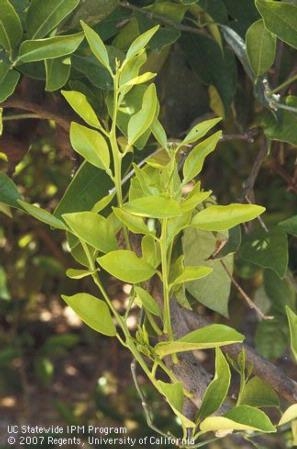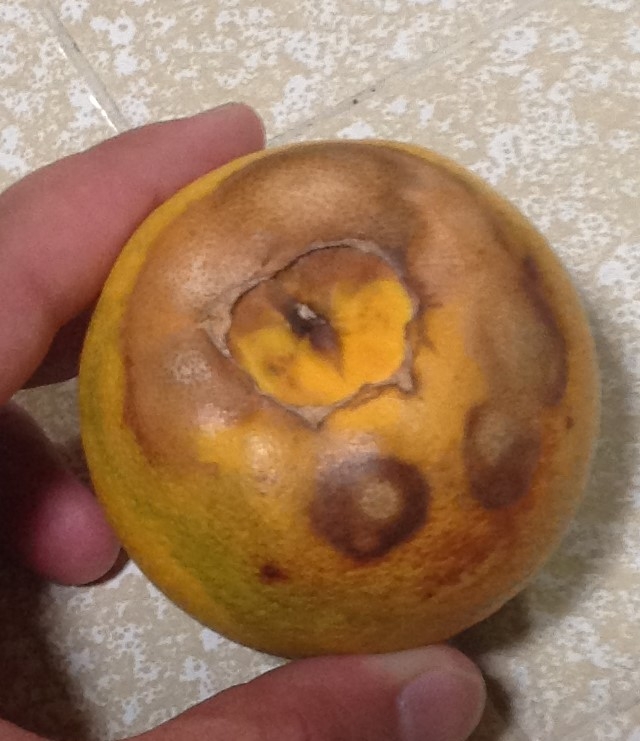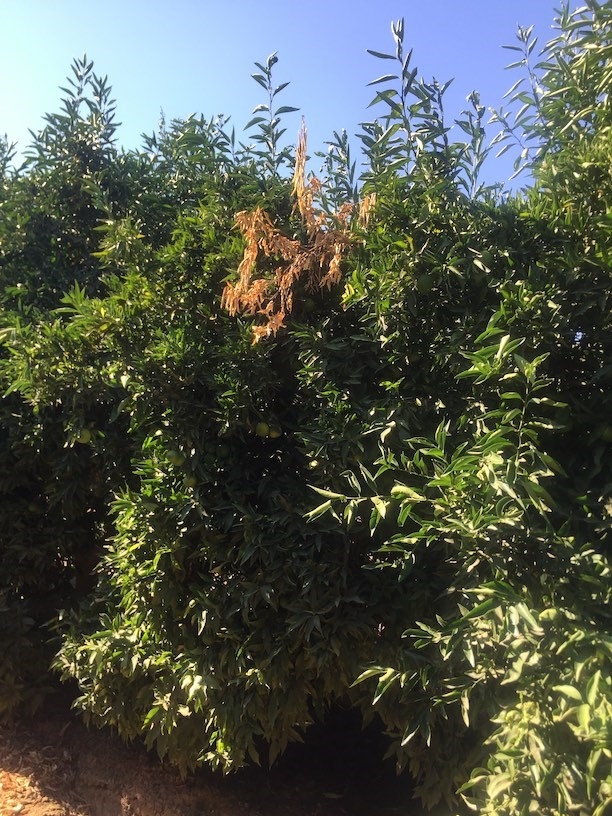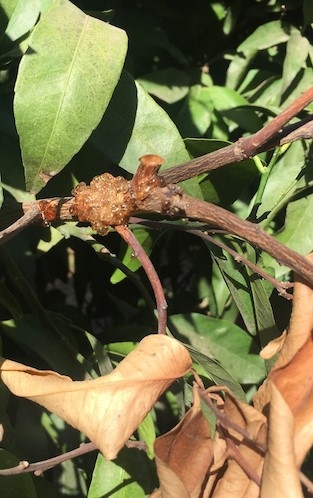
Posts Tagged: water stress
Colletotrichum Shoot Dieback of Citrus
|
Figure 1: Citrus shoot dieback (top) and gummosis (bottom) caused by Colletrotrichum. |
A new disease of citrus has been found in the main growing regions of the Central Valley of California. The causal agents of this disease were identified as species of Colletotrichum, which are well-known pathogens of citrus and other crops causing anthracnose diseases. Several growers and nurserymen in various orchards in the Central Valley first noticed the disease in 2013. Symptoms include leaf chlorosis, crown thinning, gumming on twigs and shoots dieback, and in severe cases, death of young trees. The most characteristic symptoms of this disease are the gum pockets, which appear on young shoots either alone or in clusters and the dieback of twigs and shoots (Fig.1). Field observations indicate that symptoms initially appear during the early summer months and continue to express until the early fall. These symptoms were primarily reported from clementine, mandarin, and navel orange varieties. In order to determine the main cause of this disease, field surveys were conducted in several orchards throughout the Central Valley. Isolations from symptomatic plant samples frequently yielded Colletotrichum species. Morphological and molecular phylogenetic studies allowed the identification of two distinct species of Colletotrichum (Colletotrichum karstii and Colletotrichum gloeosporioides) associated with twig and shoot dieback. Interestingly, these Colletotrichum species were also isolated from cankers in larger branches. Although C. gloeosporioides is known to cause anthracnose on citrus, a post-harvest disease causing fruit decay, it has not been reported to cause shoot dieback of citrus. C. karstii however has not been reported previously from citrus in California and our research team is currently conducting field and green house studies to determine the pathogenicity of this species in citrus. At present, it is unclear how widespread this disease is in California orchards or how many citrus varieties are susceptible to this disease. Pest control advisors are monitoring citrus trees for the presence of the disease in the Central Valley (particularly clementine, mandarin, and navel varieties) during the early summer months. Continuing research led by Dr. Akif Eskalen in collaboration with Dr. Florent Trouillas is focused on further understanding the biology of the fungal pathogens as well as factors influencing disease expression in order to develop management strategies against this emerging disease.
Drought Induced Problems in Our Orchards
Drought Induced Problems in Our Orchards
Abiotic disorders are plant problems that are non-infective. They are not caused by an organism, but through their damage, they may bring on damage caused by organisms. Think of a tree hit by lightning or a tractor. The damage breaches the protective bark which allows fungi to start working on the damaged area, eventually leading to a decayed trunk. It was the mechanical damage, though that set the process in motion.
Too much or too little water can also predispose a plant to disease. Think of Phytophthora root rot or even asphyxiation that can come from waterlogging or too frequent irrigations.
Salinity Effects from Lack of Water
Lack of water and especially sufficient rainfall can lead to salinity and specific salts like boron, sodium and chloride accumulating in the root zone. This happens from a lack of leaching that removes native soil salts from the root zone or the salts from the previous salt-laden irrigation from the root zone. These salts cause their own kind of damage, but they can also predispose a tree to disorders, disease and invertebrate (insect and mite) damage.
Lack of water and salt accumulation act in a similar fashion. Soil salt acts in competition with roots for water. The more soil salt, the harder a tree needs to pull on water to get what it needs. The first symptom of lack of water or salt accumulation may be an initial dropping of the leaves. If this condition is more persistent, though we start to see what is called “tip burn” or “salt damage”. Southern California is tremendously dependent on rainfall to clean up irrigation salts, and when rain is lacking, irrigation must be relied on to do the leaching
As the lack of leaching advances (lack of rainfall and sufficient irrigation leaching) the canopy thins from leaf drop, exposing fruit to sunburn and fruit shriveling.
Leaf drop and fruit shriveling in avocado.
In the case of sensitive citrus varieties like mandarins, water stress can lead to a pithy core with darker colored seeds, almost as if the fruit had matured too long on the tree.
Total salinity plays an important factor in plant disorder, but also the specific salts. These salts accumulate in the older leaves, and cause characteristic symptoms that are characteristic in most trees. Boron will appear on older leaves, causing an initial terminal yellowing in the leaf that gradually turns to a tip burn.
Often times it is hard to distinguish between chloride, sodium and total salinity damage. It is somewhat a moot point, since the method to control all of them is the same – increased leaching. There is no amendment or fertilizer that can be applied that will correct this problem. The damage symptoms do not go away until the leaf drops and a new one replaces it. By that time hopefully rain and/or a more efficient irrigation program has been put in place.
The Impact of Drought on Nutrient Deficiencies
Salinity and drought stress can also lead to mineral deficiencies. This is either due to the lack of water movement carrying nutrients or to direct completion for nutrients. A common deficiency for drought stressed plants is nitrogen deficiency from lack of water entraining that nutrient into the plant.
This usually starts out in the older tissue and gradually spreads to the younger tissue in more advanced cases.
The salts in the root zone can also lead to competition for uptake of other nutrients like calcium and potassium. Apples and tomatoes are famous for blossom end rot when calcium uptake is low, but we have also seen it in citrus. Low calcium in avocado, and many other fruits, leads to lower shelf life. Sodium and boron accumulation in the root zone can lead to induced calcium deficiencies and increased sodium can also further lead to potassium deficiencies. Leaching can help remove these competitive elements.
Drought Effect on Tree Disease
Drought and salt stress can also lead to disease, but in many cases once the problem has been dealt with the disease symptoms slowly disappear. They are secondary pathogens and unless it is a young tree (under three years of age) or one blighted with a more aggressive disease, the disease condition is not fatal. Often times, in the best of years, on hilly ground these diseases might be seen where water pressure is lowest or there are broken or clogged emitters. The symptoms are many – leaf blights, cankers, dieback, gummosis – but they are all caused by decomposing fungi that are found in the decaying material found in orchards, especially in the naturally occurring avocado mulch or artificially mulched orchards. Many of these fungi are related Botryosphaerias, but we once lumped then all under the fungus Dothiorella. These decay fungi will go to all manner of plant species, from citrus to roses to Brazilian pepper.
Another secondary pathogen that clears up as soon as the stress is relieved is bacterial canker in avocado. These ugly cankers form white crusted circles that ooze sap, but when the tree is healthy again, the cankers dry up with a little bark flap where the canker had been.
Drought Effect on Pests
Water/salt stress also makes trees more susceptible to insect and mite attack. Mites are often predated by predacious mites, and when there are dusty situations, they can't do their jobs efficiently and mites can get out of hand. Mite damage on leaves is often noted in well irrigated orchards along dusty picking rows
Many borers are attracted to water stressed trees and it is possible that the Polyphagous and Kuroshio Shot Hole Borers are more attracted to those trees.
And then we have conditions like Valencia rind stain that also appears in other citrus varieties. We know it will show up in water stressed trees, but we aren't sure what the mechanism that causes this rind breakdown just at color break. Could it be from thrips attracted to the stressed tree or a nutrient imbalance, it's not clear?
Water and salt stress can have all manner of effects on tree growth. It should lead to smaller trees, smaller crops and smaller fruit. The only way to manage this condition is through irrigation management. Using all the tools available, such as CIMIS, soil probes, soil sensors, your eyes, etc. and good quality available water are the way to improve management of the orchard to avoid these problems.
Scroll down for Images
Tip Burn, notice sun burn bottom right hand fruit
Endoxerosis with dried out core
Boron toxicity
Nitrogen deficiency
Blossom end rot
Potassium deficiency
Bot gumming in lemon
Black Streak in Avocado
Bacterial Canker
Citrus red mite
Polyphagous Shot Hole Borer damage on avocado
Valencia Rind Stain

avocado drought canopy

nitrogen deficiency

endoxerosis 4

boron toxicity citrus 1

blossom end rot lemon

potassium deficiency avocado

gumming dothiorella

avocado black streak 1

bacterial canker avocado

citrus red mite

PSHB damage
Citrus Endoxerosis - Drought Effect?
Recently some 'W. Murcott' mandarins were shown to me. Brown spots in the core of the fruit. Another problem caused by drought and lack of leaching rains? Endoxerosis, also called internal decline, dry core, yellow tip, dry and blossom end decline is often confused with Alternaria rot which frequently accompanies or follows it. Internal tissues back of the stylar end break down, dry and become pinkish or brownish in color. Gum commonly forms in the core and either in or nest to the rind. Green fruits lose luster and frequently but not always develop a yellow color in circular areas surround the stylar end. The cut fru9i shows the gummy pinkish to brownish mass of partially dried and collapsed tissue. Gumming may even extend into the twig bearing the affected fruit. When the fruit turns color, the malady is more difficult to detect without cutting.
The cause is believed to be related to water and the physiological conditions within the tree and fruit and temperature conditions in the air and soil influencing transpiration and water stress. It is suggested therefore that water conditions in the soil be kept as favorable for tree heath as possible and pick on time so that they are not over mature.
From: The Citrus Industry, Volume IV, Editor: Walter Reuther, UC Press
In other words, make sure to leach the root zone of accumulated salts from previous irrigations and pray for rain.
Craig Kallsen in Kern County says he often sees this in young mandarins especially on the south and west sides of the canopy, to the point that growers will not even bother to harvest this fruit until the trees are older. The fruit just transpires so much water when it's not shaded that the fruit just dries out.
If my Latin serves me right: endo - inside, xeric - dry. Dry Inside.

endoxerosis 3
Soil Moisture Sensors
Soil Moisture Sensors
Tensiometers Electrical Resistance Blocks Neutron Probes Di-Electric Sensors More Info
Jim Wolpert, University of California, Davis
Soil Moisture Content
The quantity of water in soil is called the soil moisture content. After rainfall or irrigation, some water drains from the soil by the force of gravity. The remaining water is held in the soil by a complex force known as surface tension and varies depending on the amount of sand, silt, and clay. Sands, with larger particles and smaller total surface area, will hold less water than clays, which have much smaller particles and larger total surface area. The drier the soil, the greater the surface tension, and the more energy it will take for a plant to extract water.
Vineyard managers often measure soil water content as a guide to determine their irrigation timings and amounts. There are several methods for monitoring soil water content. Correlating these methods with actual inches of moisture per foot of soil is very complicated (see Recommended Links) but at the very least can help a grower to identify patterns of water use, depth of irrigation, and soil water content trends over time.
Tensiometers
A tensiometer, as its name implies, is a device for measuring soil moisture tension. The design is a simple tube with a porous cup at the lower end and a vacuum gauge on top. The tube is filled with water, sealed airtight, and placed in soil. As soil dries, water is pulled from the porous cup into the soil, creating a vacuum and causing the gauge to move. As soil continues to dry, more water is pulled out and the suction increases. As soil re-wets after a rain or irrigation, water moves back into the cup and the suction decreases. Installing tensiometers in soil requires attention to detail to obtain accurate readings (see Recommended Links for installation downloads).
Tensiometers are usually placed as a pair with the shorter tube positioned in the middle of the rooting zone (e.g., 18 inches deep) and a longer tube positioned near the bottom of the rooting zone (3 to 4 feet deep). Growers can use the difference between the two tubes to monitor water usage and determine the effective depth of irrigation. At least two stations (two tubes per station) are recommended per field, or more depending on soil variability.
Tensiometers have the advantage of being inexpensive, and easy to install, maintain, and read. They are better in fine-textured soils where good contact can be made between the porous cup and the soil. They do not work well in coarse sands where good contact may not be possible. Because the gauges are aboveground, the units are prone to damage by vineyard equipment.
Electrical Resistance Blocks
Electrical resistance blocks are also known as gypsum blocks or soil moisture blocks. They are simple devices with two electrodes embedded in a block of gypsum or other similar material. When blocks are buried in soil, water moves into or out of the block, depending on the moisture of the soil, changing the resistance between the two electrodes. Like tensiometers, gypsum blocks are cheap and easy to install. They are usually installed in at least two stations per field, at two depths, and must be installed correctly to provide accurate readings. Some block designs perform better under wet soil conditions and some correct for soil temperature. The meter used to read the blocks can be moved from field to field, but is specific to the block design (i.e., it is not a simple ohm meter). The wires aboveground are much less prone to damage by equipment compared to tensiometers.
Neutron Probe
A neutron probe uses a radioactive source for measuring soil moisture. A tube, usually made of PVC or aluminum, is installed in soil to a depth of interest and the radioactive probe is lowered into soil to measure soil moisture at as many depths as desired. The probe emits fast neutrons that are slowed by water in the soil in a way that can be calibrated to the soil water content. The probe has a significant advantage, especially for perennial crops, because access tubes are easy to install and relatively permanent. Another advantage is the reading accounts for a spherical area about 10 inches in diameter, much greater than other methods. The major limitation to this method is the probe itself; it is expensive and the presence of a radioactive source triggers requirements for operators to be trained and licensed in handling, storage, and use. In some production regions, service providers are available, usually at a fixed cost per access tube for a growing season.
Di-electric Sensors
Di-electric sensors measure the di-electric constant of soil, a characteristic that changes with changing soil moisture. A common method is called time domain reflectometry, or TDR. The theory behind how this method works is too complicated to be discussed here. The advantage of these types of systems is that they are designed to be left in place and provide continuous readings of soil moisture. The disadvantages are that the units are expensive and read soil moisture only a very small distance from the unit.
Conclusion
All measures of soil moisture suffer from the same limitation — the value of the information is dependent on the extent to which the soil where the measurements are taken reflects the rest of the field. Where soil variability is high, growers must exercise caution in relying too heavily on relatively few measurements.
Recommended Resources
Irrigation of Winegrapes, University of California
Soil moisture management, Irrometer
Soilmoisture Equipment Corporation
Irrigation Basics for Eastern Washington Vineyards, Washington State University
Reviewed by Ed Hellman, Texas AgriLife Extension and Eric Stafne, Mississippi State University

soil
IRRIGATION STRESS AND EARLY-FRUIT MATURITY
To maximize profits in the early navel orange market, growers need to have large fruit size and sufficient yellow-orange color and a high enough sugar-acid ratio to meet or exceed the legal minimum harvesting standards. Growers of early-maturing navel oranges in Kern County use different strategies to produce these oranges. Some growers irrigate at full evapotranspiration rates nearly up to harvest with the belief this will maximize fruit size, while others begin deficit irrigating a month or two prior to harvest to maximize development of sugar and color to promote earlier maturity. Little information exists in the literature to assist growers in making decisions related to producing early maturing navels such as Beck,Fukumoto and Thompson Improved. After three years of research, we have elucidated some of the trade offs that relate to irrigation strategies and early navel fruit production.
Three different irrigation treatments, defined as low, mid and high, were developed based on the relative amounts of irrigation water applied to the test plots. Each plot consisted of 10 trees in a central row, bordered by 10 similarly irrigated trees in the two adjacent rows. Each treatment was replicated 5 times. The same irrigation treatment was applied to the same plots for the first two years, while in the third year the low treatment was changed to the high treatment to provide information on how rapidly the trees would recover from stress. The different irrigation treatments were administered by using irrigation emitters with different flow rates and by differentially shutting off water to some treatments as needed to achieve desired stress levels. Between growing seasons, the top three feet of soil profile was refilled with water during the winter and differential irrigation began in early August. Measurable differences in tree shaded stem water potential among treatment usually were noted by early September. In the second year of the experiment (2007), the low and mid-
irrigation treatments applied approximately 38 and 71 percent, respectively on average, of the water of the high treatment. Water potential measurements made mid-day on shaded, interior leaves demonstrated that good separation was achieved among the three treatments. In 2007, for example, shaded stem water potential measurement in early September were about -9, -12, and -18 bars for the high, mid and low irrigation treatments, respectively and at harvest in mid October were -12, 18, -24, respectively. Neutron probe measurements also demonstrated that trees differentially depleted available water stored in the soil as the season progressed (data not shown). In 2007, differences in applied water among the treatments were large. Including the increased quantity of water applied to refill the soil profile in the winter, 3.55, 2.58 and 2.11 acre feet of water on a per acre basis, were applied to the high, mid and low irrigation treatments respectively, from October 30 2006 to harvest, October 15 2007. Rainfall was minimal.
Again, using 2007 as an example, as the level of applied water decreased, soluble solids (i.e. sugars) and titratable acid, were greater at harvest, although the sugar acid ratio was not different (see Table 1). Rows in the experimental orchard were oriented east and west. Fruit on the south side of the tree had higher soluble solids concentration and sugar/acid ratio than fruit on the north side of the tree, regardless of irrigation treatment. Fruit juiciness, either measured as weight of juice to weight of fruit (see Table 1) or volume of juice per weight of fruit (results not shown) were not different among irrigation treatments, suggesting the increase in sugars and acid was the result of osmotic adjustment and not fruit dehydration. We were also interested in seeing if the differential irrigation treatments influenced eating quality of the fruit. To test this idea, we provided fruit from the highest and lowest irrigation treatments of 2007 and 2008 to volunteer panelists at the UC Kearney Ag Center and asked if they could detect any differences between the fruit. In both years the panelists could not detect differences between fruit from the two irrigation treatments, suggesting that the increase in soluble solids in the low irrigation treatment was not sufficient to influence eating quality.
In 2007, yield and grade decreased as the amount of applied water decreased (see Table 2). Fruit in the high and mid irrigation treatments peaked on size 56 per carton and on size 72 per carton in low treatment (data not shown). The decrease in fruit grade at pack-out appeared to be largely due to a more oblong shape. The negative yield, fruit size and grade effects measured in the low and mid treatments in 2007 were probably the cumulative result of deficit irrigation in Years 1 and 2 and not just Year 2 alone. Reduced rates of irrigation did increase the color in the fruit compared to the high irrigation treatment (see Table 3) and this occurred every year.
The deleterious effects on yield, and grade on the trees in the low-irrigation treatments suggested that not much would be gained by continuing this level of stress for a third season in the same plots. In 2008, the low irrigation treatment was replaced by a high irrigation treatment and, at harvest, yield by weight and fruit numbers were not different from the control high-irrigation treatment. This observation demonstrated that the Beck navels rebounded quickly from the low irrigation stress of 2006 and 2007. The mid level irrigation stress of 2006 and 2008 was less severe than that of 2007, and yield and fruit quality was not as adversely affected as in 2007.
This study provides information on some of the trade offs that might be expected among fruit yield, size, grade, sugar and color in relation to reduced irrigation as harvest approaches. Information from this study will be available in greater detail in the near future. How growers respond to this information will depend on their approach to profiting in the early navel market and how much water will be available for irrigation. If reducing water use, while minimizing effects on yield and fruit quality compared to fully irrigated orchards, is the primary goal of the grower, work by Dr. Goldhamer, UC irrigation specialist, demonstrated that regulated deficit irrigation in the mid-May through mid-July time period would be the best strategy.

navel orange




